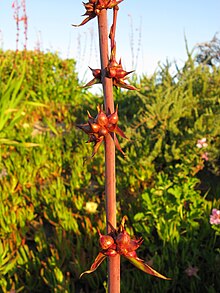
Back خط جنسي Arabic Keimbahn German Línea germinal Spanish Iturata Finnish Lignée germinale French Liña xerminal Galician Garis benih ID Linea germinale Italian 생식계열 Korean Kiembaan Dutch


In biology and genetics, the germline is the population of a multicellular organism's cells that develop into germ cells. In other words, they are the cells that form gametes (eggs and sperm), which can come together to form a zygote. They differentiate in the gonads from primordial germ cells into gametogonia, which develop into gametocytes, which develop into the final gametes.[1] This process is known as gametogenesis.
Germ cells pass on genetic material through the process of sexual reproduction. This includes fertilization, recombination and meiosis. These processes help to increase genetic diversity in offspring.[2]
Certain organisms reproduce asexually via processes such as apomixis, parthenogenesis, autogamy, and cloning.[3][4] Apomixis and Parthenogenesis both refer to the development of an embryo without fertilization. The former typically occurs in plants seeds, while the latter tends to be seen in nematodes, as well as certain species of reptiles, birds, and fish.[5][6] Autogamy is a term used to describe self pollination in plants.[7] Cloning is a technique used to creation of genetically identical cells or organisms.[8]
In sexually reproducing organisms, cells that are not in the germline are called somatic cells. According to this definition, mutations, recombinations and other genetic changes in the germline may be passed to offspring, but changes in a somatic cell will not be.[9] This need not apply to somatically reproducing organisms, such as some Porifera[10] and many plants. For example, many varieties of citrus,[11] plants in the Rosaceae and some in the Asteraceae, such as Taraxacum, produce seeds apomictically when somatic diploid cells displace the ovule or early embryo.[12]
In an earlier stage of genetic thinking, there was a clear distinction between germline and somatic cells. For example, August Weismann proposed and pointed out, a germline cell is immortal in the sense that it is part of a lineage that has reproduced indefinitely since the beginning of life and, barring accident, could continue doing so indefinitely.[13] However, it is now known in some detail that this distinction between somatic and germ cells is partly artificial and depends on particular circumstances and internal cellular mechanisms such as telomeres and controls such as the selective application of telomerase in germ cells, stem cells and the like.[14]
Not all multicellular organisms differentiate into somatic and germ lines,[15] but in the absence of specialised technical human intervention practically all but the simplest multicellular structures do so. In such organisms somatic cells tend to be practically totipotent, and for over a century sponge cells have been known to reassemble into new sponges after having been separated by forcing them through a sieve.[10]
Germline can refer to a lineage of cells spanning many generations of individuals—for example, the germline that links any living individual to the hypothetical last universal common ancestor, from which all plants and animals descend.
- ^ Yao, C., Yao, R., Luo, H., & Shuai, L. (2022). Germline specification from pluripotent stem cells. Stem cell research & therapy, 13(1), 74. https://doi.org/10.1186/s13287-022-02750-1
- ^ Zickler, D., & Kleckner, N. (2015). Recombination, Pairing, and Synapsis of Homologs during Meiosis. Cold Spring Harbor perspectives in biology, 7(6), a016626. https://doi.org/10.1101/cshperspect.a016626
- ^ Tarín, Juan J.; Cano, Antonio, eds. (2000). Fertilization in protozoa and metazoan animals: cellular and molecular aspects. Berlin Heidelberg: Springer. ISBN 978-3-540-67093-3.
- ^ Lowe, Andrew; Harris, Stephen; Ashton, Paul (1 April 2000). Ecological Genetics: Design, Analysis, and Application. John Wiley & Sons. ISBN 978-1-444-31121-1.
- ^ Niccolò, T., Anderson, A. W., & Emidio, A. (2023). Apomixis: oh, what a tangled web we have!. Planta, 257(5), 92. https://doi.org/10.1007/s00425-023-04124-0
- ^ Dudgeon, C. L., Coulton, L., Bone, R., Ovenden, J. R., & Thomas, S. (2017). Switch from sexual to parthenogenetic reproduction in a zebra shark. Scientific reports, 7, 40537. https://doi.org/10.1038/srep40537
- ^ Eckert, Christopher G. (February 2000). "Contributions of Autogamy and Geitonogamy to Self-Fertilization in a Mass-Flowering, Clonal Plant". Ecology. 81 (2). Ecological Society of America: 532–542. doi:10.1890/0012-9658(2000)081[0532:COAAGT]2.0.CO;2. ISSN 0012-9658 – via John Wiley and Sons.
- ^ Bonetti, G., Donato, K., Medori, M. C., Dhuli, K., Henehan, G., Brown, R., Sieving, P., Sykora, P., Marks, R., Falsini, B., Capodicasa, N., Miertus, S., Lorusso, L., Dondossola, D., Tartaglia, G. M., Cerkez Ergoren, M., Dundar, M., Michelini, S., Malacarne, D., Beccari, T., … Bertelli, M. (2023). Human Cloning: Biology, Ethics, and Social Implications. La Clinica terapeutica, 174(Suppl 2(6)), 230–235. https://doi.org/10.7417/CT.2023.2492
- ^ C.Michael Hogan. 2010. Mutation. ed. E.Monosson and C.J.Cleveland. Encyclopedia of Earth. National Council for Science and the Environment. Washington DC Archived April 30, 2011, at the Wayback Machine
- ^ a b Brusca, Richard C.; Brusca, Gary J. (1990). Invertebrates. Sunderland: Sinauer Associates. ISBN 978-0878930982.
- ^ Akira Wakana and Shunpei Uemoto. Adventive Embryogenesis in Citrus (Rutaceae). II. Postfertilization Development. American Journal of Botany Vol. 75, No. 7 (Jul., 1988), pp. 1033-1047 Published by: Botanical Society of America Article Stable URL: https://www.jstor.org/stable/2443771
- ^ K V Ed Peter (5 February 2009). Basics Of Horticulture. New India Publishing. pp. 9–. ISBN 978-81-89422-55-4.
- ^ August Weismann (1892). Essays upon heredity and kindred biological problems. Clarendon press.
- ^ Watt, F. M. and B. L. M. Hogan. 2000 Out of Eden: Stem Cells and Their Niches Science 287:1427-1430.
- ^ Radzvilavicius, Arunas L.; Hadjivasiliou, Zena; Pomiankowski, Andrew; Lane, Nick (2016-12-20). "Selection for Mitochondrial Quality Drives Evolution of the Germline". PLOS Biology. 14 (12): e2000410. doi:10.1371/journal.pbio.2000410. ISSN 1545-7885. PMC 5172535. PMID 27997535.
© MMXXIII Rich X Search. We shall prevail. All rights reserved. Rich X Search